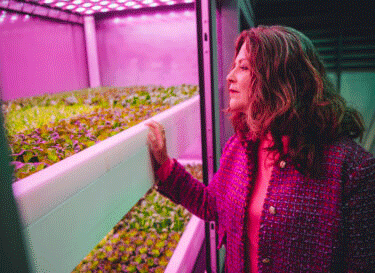The global agriculture industry is facing unprecedented challenges. As the world population steadily rises, reaching an estimated 9.7 billion by 2050, food demand is increasing faster than traditional farming methods can handle. Simultaneously, climate change is wreaking havoc on conventional agriculture, with unpredictable weather patterns, extended droughts, and extreme storms threatening crops and reducing yields. In this critical context, new solutions like vertical farming have emerged, promising efficiency and sustainability.
The Vertical Advantage
Traditional agriculture relies heavily on horizontal space and favorable weather conditions. Vertical farming, by contrast, makes use of a controlled, indoor environment where crops grow stacked in layers, often in urban or industrial settings. This system allows year-round production, independent of outdoor climate conditions. Infinite Acres, a Dutch-American tech firm, has become a pioneer in this field, showing how technology can transform food production.
The statistics speak for themselves. Vertical farms use 400 times less land compared to traditional agriculture to yield the same amount of crops. Water usage is reduced by up to 95%, and the need for pesticides is eliminated thanks to the closed environment. According to Infinite Acres’ CEO, Tisha Livingston, the combination of optimal lighting, tailored nutrients, and precise climate control allows crops to grow faster and with higher yields. For instance, while field-grown iceberg lettuce takes between 90 and 120 days to harvest, the same crop can be ready in just 24 days in a vertical farm.
High-Tech Solutions for Modern Challenges
Infinite Acres’ technology integrates sensors, cameras, and AI-driven analytics to monitor plant health and growth stages in real time. The automated systems adjust light, carbon dioxide levels, and nutrient delivery to ensure each plant receives exactly what it needs. This precision reduces crop loss and improves resource efficiency. Data collected from these farms continually refines the growing process, making it more efficient over time.
This high-tech agriculture is not just about efficiency but also about safety and health. In regions like the United States, where pesticide use remains widespread, vertical farming offers a pesticide-free alternative. Pesticides are linked to a variety of health concerns, including cancer and developmental disorders, and pose a serious threat to biodiversity. Infinite Acres’ approach eliminates these concerns while maintaining high productivity.
Tackling the Cost Barrier
Despite its many advantages, vertical farming has not yet become mainstream. The primary barrier remains the high cost of setting up indoor farms. For example, Infinite Acres’ sister company, 80 Acres Farms, has invested over $100 million in a single production site in Kentucky. This facility produces around 2.5 million kilograms of food annually, including leafy greens, herbs, tomatoes, and cucumbers. Such substantial initial investments make it difficult for startups to secure traditional financing from banks and investors.
However, these costs may become more manageable as the technology matures and scales. The Netherlands, with its advanced agricultural and technological expertise, is playing a key role in developing more efficient systems. Partnerships with companies like Signify for lighting solutions and Siemens for software and automation illustrate the collaborative effort required to advance vertical farming.
Research and Global Impact
The company’s new research center in The Hague focuses on developing innovative ways to reduce resource consumption and expand crop varieties suitable for vertical farming. Infinite Acres is even exploring new seed genetics tailored to indoor farming, prioritizing traits like taste and nutritional value over drought resistance, which is irrelevant in controlled environments.
The ultimate goal is global impact. In the United States, where food often travels long distances from farm to table, vertical farming can offer fresher produce, reduce food waste, and eliminate the need for extensive pesticide use. In densely populated or arid regions, vertical farms can help alleviate food deserts and make local, nutritious food more accessible.
Vertical farming is no longer a futuristic dream but a rapidly advancing solution that could reshape global food systems. By using less land and water, eliminating pesticide use, and offering more predictable yields, it holds the promise of addressing key agricultural challenges in the face of climate change. While the financial and logistical hurdles are significant, the growing expertise and technological advances suggest a bright future for vertical farming. If this model can be refined and scaled, it has the potential to revolutionize how we think about food production and security.












